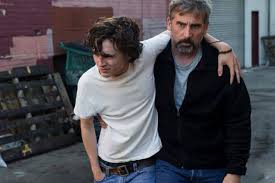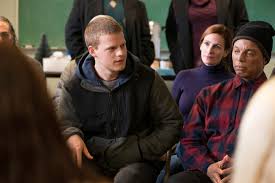Here come two posts, the first one is more of an idea, the second a suggestion for practicing what the idea is about. My question for today: How can we (who struggle with addiction) reconcile our radically different self-narratives, some of which seem so ugly, and arrive at self-acceptance and self-compassion?
We know that self-anger, self-disgust, shame, and the accompanying frustration and depression are among the greatest challenges to overcoming addiction. We feel fragmented, made of pieces that can’t possibly fit together. We crave, we choose to use, we take care of ourselves at the expense of others, and we lie (without hesitation) to protect our habit. Yet we can’t let go of the sense that we are also good, or at least have been good. We are caring, and generous, and smart, and very often responsible. How can we possibly fit these views of ourselves together?
According to thinkers and researchers in developmental psychology and adolescent development, we just lost the game of growing up. In fact philosophers and writers down through the ages have come to the same conclusion. The main task of growing up is to create a coherent narrative about who we are. A coherent self-narrative. Yet that seems to be very difficult for addicts.
A big part of our sense of self, our identity, the “me” we show others, is in fact a narrative, a story. This is who I am. This is where I came from. This is what happened to me. That caused me to do such and such. And then this happened. And now, this is where I am, this is who I am, and — most important — this is where I’m going.
I’ve written (especially in The Biology of Desire, last chapter) about how difficult it is for addicts to create and hold onto a coherent self-narrative. I’ve suggested that addicts can be helped, or can help themselves, by solidifying that narrative and (most important) extending it into the past and the future. Because of the pull of the present moment (“now appeal” — e.g., wanting only to get high today and forgetting about tomorrow) it’s crucial to stretch the time-line. We should try to extend the narrative into the past, to understand how we got to be this way, and into the future, so we can begin to imagine being someone different, someone freer and happier, and aim ourselves there deliberately. I’ve suggested that scaffolding (by therapists, friends, loved ones) can help create and maintain this extended narrative. It’s too hard to do it alone.
But it’s damn hard to do even with the best of help! Here’s why. What most of the experts miss is that we are made up of more than one narrative. We often have two or three or four going at the same time. Psychologists sometimes talk about parallel identities: e.g., I’m a parent, but I’m also an American, or I’m  also a plumber, or I’m also hot! Okay, but that stuff is easy. Multiple self-narratives are particularly challenging for addicts, because they fit together so poorly. There’s the self that often gets called the “addict self.” There’s this me who was abused, or thrown out, or traumatized in adolescence, and all I could find to feel better was this or that
also a plumber, or I’m also hot! Okay, but that stuff is easy. Multiple self-narratives are particularly challenging for addicts, because they fit together so poorly. There’s the self that often gets called the “addict self.” There’s this me who was abused, or thrown out, or traumatized in adolescence, and all I could find to feel better was this or that  drug, so that’s what I go after. That’s one “addict self.” There are others that aren’t so benign. There’s the “I’m such a loser” version — very common, very hard to shake. Or its close cousin: “I’m just a teenage dirt-bag.” In other words, a piece of shit. When I (Marc, personally) was addicted, I saw myself as sneaky and determined and defiant, all of which fit into one narrative…which didn’t resolve for years.
drug, so that’s what I go after. That’s one “addict self.” There are others that aren’t so benign. There’s the “I’m such a loser” version — very common, very hard to shake. Or its close cousin: “I’m just a teenage dirt-bag.” In other words, a piece of shit. When I (Marc, personally) was addicted, I saw myself as sneaky and determined and defiant, all of which fit into one narrative…which didn’t resolve for years.
But addicts also have self-narratives that are positive, even admirable. We may see ourselves as nurturing and compassionate, especially if we are parents (or lovers). Those are real narratives too: I had this baby and I learned to take care of her and I love her so much and I’ll continue to do anything for her. We may have self-narratives in which we are heroes or rebels, not beholden to others. Or simply victims.
The point is that these narrative threads really don’t cohere. They don’t jibe, they don’t reconcile. They are just too different to blend into a single story line. So we get torn apart by the tension between one self-narrative and another. From an email I recently received: How can I have gone back to meth, when I know that I’ll never get custody of my child now! Not ever! I hate myself so much. Or: How can I steal money from my own mother and still see myself as loving her and caring for her?! How can I be worthy of being drug-free when I’m so indulgent, so weak?! These stories cannot be merged. They are too discrepant.
 So here’s what I want to suggest. Bump up a level. Recognize that you do contain distinct, incompatible self-narratives. Create an uber-narrative that allows for each component narrative and doesn’t have to shut any of them down. Now you can let yourself get to know each of these self-narratives. Make each one conscious, talk it out, recount the plot-line, to yourself or others, write about it. But realize that they will not blend into one nice story. Bump up a level to a more insightful, wiser self who recognizes each of these radically different story
So here’s what I want to suggest. Bump up a level. Recognize that you do contain distinct, incompatible self-narratives. Create an uber-narrative that allows for each component narrative and doesn’t have to shut any of them down. Now you can let yourself get to know each of these self-narratives. Make each one conscious, talk it out, recount the plot-line, to yourself or others, write about it. But realize that they will not blend into one nice story. Bump up a level to a more insightful, wiser self who recognizes each of these radically different story  lines as real…and lets them coexist.
lines as real…and lets them coexist.
Try it. Pull yourself up to the level of the overseer. Be a real author, a real choreographer, who can shift from one plot-line to another and accept that they are not ready to be stitched together. Not yet.
I think there are at least two benefits to be had. Number 1: When you stop trying to reconcile your “addict self” with, say, your “caring self,” you release yourself from an enormous amount of tension and frustration. You are both of these. Accept them both. Number 2: By accepting each of these self-narratives as real and maybe even inevitable, and by making them conscious, you provide a space for true self-acceptance. Self-compassion. Even self-love.
………..
Next post: how this “retelling” might relate to that squishy idea we hear so much about — mindfulness.


 With Ben is Back, there was Julia Roberts’ compelling angst, and now, with A Beautiful Boy (which I also read), we feel that intense heartbreak of a parent who can do nothing more to help.
With Ben is Back, there was Julia Roberts’ compelling angst, and now, with A Beautiful Boy (which I also read), we feel that intense heartbreak of a parent who can do nothing more to help.  Only to keep loving…and losing…as if his son had cancer or leprosy. I guess I’m mad and that’s why my words are coming out this way. There is something fundamentally wrong in these portrayals. Yes, they get the drama, the heartbreak, the power of drug highs. They get the agonizing schism between the teen or young adult lost in drugs and the (generally divorced) parents who still love their kid intensely. All that is worthwhile and important. But what they don’t get is the experience. They don’t even try to approximate, to estimate, to guess at what these young drug addicts are experiencing (other than deep sighs and stretches and rapturous smiles). Why is this so opaque?
Only to keep loving…and losing…as if his son had cancer or leprosy. I guess I’m mad and that’s why my words are coming out this way. There is something fundamentally wrong in these portrayals. Yes, they get the drama, the heartbreak, the power of drug highs. They get the agonizing schism between the teen or young adult lost in drugs and the (generally divorced) parents who still love their kid intensely. All that is worthwhile and important. But what they don’t get is the experience. They don’t even try to approximate, to estimate, to guess at what these young drug addicts are experiencing (other than deep sighs and stretches and rapturous smiles). Why is this so opaque? I mean, if we can create film after film about the Vietnam War and experience the shame, guilt, and horror of soldiers watching their friends die and their deepest values twisted inside out, why can’t we even come close to portraying — not what the parent is feeling — yes, that’s important too — but what the young addict is experiencing? What could be more dramatic than that? (And isn’t that supposed to be the crisis of our time?)
I mean, if we can create film after film about the Vietnam War and experience the shame, guilt, and horror of soldiers watching their friends die and their deepest values twisted inside out, why can’t we even come close to portraying — not what the parent is feeling — yes, that’s important too — but what the young addict is experiencing? What could be more dramatic than that? (And isn’t that supposed to be the crisis of our time?)

 either one. Yes, we want that. But at 18 or 20, we can’t create it. We can only rent that property from parents who settled there and established a home there. We can only copy, and please, and behave ourselves, trading our youthful energy for the security we could never find elsewhere. And guess what: that’s not enough.
either one. Yes, we want that. But at 18 or 20, we can’t create it. We can only rent that property from parents who settled there and established a home there. We can only copy, and please, and behave ourselves, trading our youthful energy for the security we could never find elsewhere. And guess what: that’s not enough.

 In the beginning, I thrived through the social connections I developed. I felt understood, and supported for the first time in years. Following this initial connection to its members, I slowly began to accept other elements of the 12-step philosophy, allowing them to influence and shape my views on the nature of addiction and, in some ways, on my approach to life.
In the beginning, I thrived through the social connections I developed. I felt understood, and supported for the first time in years. Following this initial connection to its members, I slowly began to accept other elements of the 12-step philosophy, allowing them to influence and shape my views on the nature of addiction and, in some ways, on my approach to life.



 Ben seems to be trying with great determination to keep away from drugs. Yet the demon of addiction is doing pushups in the parking lot, just as they warn at the 12-step meeting he attends with his mom. He finds a bag of dope in the attic, but manages to avoid taking it and gives it to his mother instead. He looks the other way when dealers and drug buddies from his former life show up magically on elevators and at car windows.
Ben seems to be trying with great determination to keep away from drugs. Yet the demon of addiction is doing pushups in the parking lot, just as they warn at the 12-step meeting he attends with his mom. He finds a bag of dope in the attic, but manages to avoid taking it and gives it to his mother instead. He looks the other way when dealers and drug buddies from his former life show up magically on elevators and at car windows.  He bravely endures the cultural ambiguity of an American Christmas and tries his best to connect with his sibs and step-sibs. He’s a good guy, and he fights the good fight, but…well I don’t want to spoil it in case you decide to watch it.
He bravely endures the cultural ambiguity of an American Christmas and tries his best to connect with his sibs and step-sibs. He’s a good guy, and he fights the good fight, but…well I don’t want to spoil it in case you decide to watch it. Instead, the usual “Reader’s Digest” simplifications are offered. For example, Mom meets the doctor who first prescribed pain pills, which got Ben “hooked” years ago, and says she hopes he dies a horrible death. We know that the OxyContin surge in the 80’s and 90’s did increase exposure to opiates and fueled increased rates of addiction. But to continue to blame doctors is insane. As
Instead, the usual “Reader’s Digest” simplifications are offered. For example, Mom meets the doctor who first prescribed pain pills, which got Ben “hooked” years ago, and says she hopes he dies a horrible death. We know that the OxyContin surge in the 80’s and 90’s did increase exposure to opiates and fueled increased rates of addiction. But to continue to blame doctors is insane. As  The 12-step presence is portrayed somewhat accurately. Both the good (fellowship, honesty, and mutual respect) and the not-so-good (brain washing, propaganda, and the all-or-none trappings of the disease model) correspond well enough with reality.
The 12-step presence is portrayed somewhat accurately. Both the good (fellowship, honesty, and mutual respect) and the not-so-good (brain washing, propaganda, and the all-or-none trappings of the disease model) correspond well enough with reality. There is some recognition that addicts have choices. Ben fights his impulses bravely, and he makes sensible choices to avoid contact with the people and places that serve as triggers. And yet there is this creepy sense of fatalism sneaking up on Ben and other addicts. As though whatever choices they think they’re making, they’re bound to succumb. By the way, addiction isn’t referred to as “a disease” in this movie. Yet the miasma of an alien presence or infection lurks behind much of the dialogue and plot.
There is some recognition that addicts have choices. Ben fights his impulses bravely, and he makes sensible choices to avoid contact with the people and places that serve as triggers. And yet there is this creepy sense of fatalism sneaking up on Ben and other addicts. As though whatever choices they think they’re making, they’re bound to succumb. By the way, addiction isn’t referred to as “a disease” in this movie. Yet the miasma of an alien presence or infection lurks behind much of the dialogue and plot. Junkies are portrayed as zombies. They are the opposite of clean. They’re dirty. They hover in alleyways, under bridges, around trashcans brimming with burning litter. It’s a classic and grossly overdone stereotype. When I was shooting heroin or morphine in my twenties , garbage-strewn alleys and river banks were not my preferred home away from home.
Junkies are portrayed as zombies. They are the opposite of clean. They’re dirty. They hover in alleyways, under bridges, around trashcans brimming with burning litter. It’s a classic and grossly overdone stereotype. When I was shooting heroin or morphine in my twenties , garbage-strewn alleys and river banks were not my preferred home away from home. But here’s my biggest beef. People who take drugs are shown to be occupied by some demonic force (or disease, or what have you) that makes them another species. They are not anything like normal people. They live in a different world, they’re not to be trusted, and they ought to be sent away to residential rehabs (where they won’t infect the rest of us) until the demon is exorcised — itself a rare event. This dichotomous “us vs them” perspective is the real message of the movie.
But here’s my biggest beef. People who take drugs are shown to be occupied by some demonic force (or disease, or what have you) that makes them another species. They are not anything like normal people. They live in a different world, they’re not to be trusted, and they ought to be sent away to residential rehabs (where they won’t infect the rest of us) until the demon is exorcised — itself a rare event. This dichotomous “us vs them” perspective is the real message of the movie. balance to their lives — what I referred to as “substance” last post. The cause of addiction can be found in mall culture itself (portrayed in the movie as a sort of heaven on earth), the rampant commercialism that sucks meaning out of day-to-day life, the often immutable stamp of privilege vs. poverty and the stultifying dead-end lives of those who don’t make the cut. Not to mention the sheer hypocrisy of a society that proclaims Christian values but rewards self-serving, self-protective priorities. I wonder if Ben was infected by these horrors rather than a magical drug high, and whether that’s what made it so hard for him to quit.
balance to their lives — what I referred to as “substance” last post. The cause of addiction can be found in mall culture itself (portrayed in the movie as a sort of heaven on earth), the rampant commercialism that sucks meaning out of day-to-day life, the often immutable stamp of privilege vs. poverty and the stultifying dead-end lives of those who don’t make the cut. Not to mention the sheer hypocrisy of a society that proclaims Christian values but rewards self-serving, self-protective priorities. I wonder if Ben was infected by these horrors rather than a magical drug high, and whether that’s what made it so hard for him to quit.
 A substance is what fills up a space. The lack of substance equals, well, nothingness. When people talk about their addiction they often talk about a sense of profound emptiness, a psychological void, that gets filled by a something they can only get from what they’re addicted to. To replace a sense of nothingness with a sense of somethingness (what else to call it!) is more powerful than words like “pleasure,” “relief,” or “satisfaction” can possibly convey.
A substance is what fills up a space. The lack of substance equals, well, nothingness. When people talk about their addiction they often talk about a sense of profound emptiness, a psychological void, that gets filled by a something they can only get from what they’re addicted to. To replace a sense of nothingness with a sense of somethingness (what else to call it!) is more powerful than words like “pleasure,” “relief,” or “satisfaction” can possibly convey. Berridge has compared this urge to the desperation of a starving animal seeking food. So it may be useful to view substance and behavioural addictions as fulfilling biological needs, or at least their psychological
Berridge has compared this urge to the desperation of a starving animal seeking food. So it may be useful to view substance and behavioural addictions as fulfilling biological needs, or at least their psychological  expression. Whether we take pills, snort powder, smoke, or inject, we are putting something into our bodies. This “inputting” is a behavioural prototype. It’s primal. It’s how we eat. In the case of binge eating, the target of the behaviour makes obvious biological sense. But perhaps all behavioural addictions relate to biological needs: e.g., winning against competitors (gambling), sexual needs (obviously sex and porn addiction), even social inclusion
expression. Whether we take pills, snort powder, smoke, or inject, we are putting something into our bodies. This “inputting” is a behavioural prototype. It’s primal. It’s how we eat. In the case of binge eating, the target of the behaviour makes obvious biological sense. But perhaps all behavioural addictions relate to biological needs: e.g., winning against competitors (gambling), sexual needs (obviously sex and porn addiction), even social inclusion  (internet addiction) and resource acquisition (compulsive shopping). In my book, The Biology of Desire, I make the case that addiction serves symbolic goals. For example, the warm feeling you get from opiates symbolizes the warmth that comes from being hugged or cuddled (no small matter for us mammals).
(internet addiction) and resource acquisition (compulsive shopping). In my book, The Biology of Desire, I make the case that addiction serves symbolic goals. For example, the warm feeling you get from opiates symbolizes the warmth that comes from being hugged or cuddled (no small matter for us mammals). of addicts in downtown Vancouver, mostly aboriginal, mostly from foster homes, mostly abused or neglected in childhood, highlights the enormous holes in the lives of people with devastated attachment histories — holes filled by drug use.
of addicts in downtown Vancouver, mostly aboriginal, mostly from foster homes, mostly abused or neglected in childhood, highlights the enormous holes in the lives of people with devastated attachment histories — holes filled by drug use. 